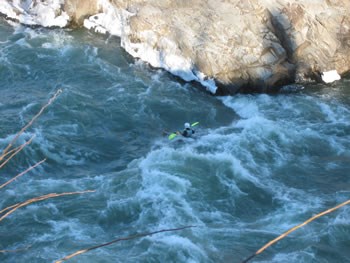
NPS VIPs Potomac River Gorge Paddling Safety The sport of paddling down rivers is becoming increasingly popular among recreation enthusiasts. The Potomac River Gorge offers an array of options for paddlers to experience such as surf and play waves, attainment up the gorge, mystery move spots for squirt boaters, lessons for those who want to learn, and all a very short distance from our Nation's Capital. With the abundance of opportunities to recreate in the gorge, it is important to be aware of the inherent dangers that can happen. In the last decade several drownings and multiple incidents of kayaker swims, injuries, and loss of equipment have occurred here. Recreate on the Potomac River safely, and do not underestimate its power! In the Gorge, there is a high volume of water with a fast, powerful flow. The Potomac runs through the Great Falls and then funnels downstream through the narrow Mather Gorge. Be aware that even small changes in water levels can dramatically increase the difficulty of the whitewater, within hours on the same day! Your safety while on and around the Potomac River is our concern. 
NPS Paddling Safety Essentials:
Resources
*Interested in obtaining a commercial use authorization to run tours in Great Falls Park? Please call 703-289-2522 or email for more information.*
Class I: Easy. Fast moving water with riffles and small waves. Few obstructions, all obvious and easily missed with little training. Risk to swimmers is slight; self-rescue is easy. Class II: Novice. Straightforward rapids with wide, clear channels which are evident without scouting. Occasional maneuvering may be required, but rocks and medium sized waves are easily missed by trained paddlers. Swimmers are seldom injured and group assistance, while helpful, is seldom needed. Class III: Intermediate. Rapids with moderate, irregular waves which may be difficult to avoid and which can swamp an open canoe. Complex maneuvers in fast current and good boat control in tight passages or around ledges are often required; large waves or strainers may be present but are easily avoided. Strong eddies and powerful current effects can be found, particularly on large-volume rivers. Scouting is advisable for inexperienced parties. Injuries while swimming are rare; self-rescue is usually easy but group assistance may be required to avoid long swims. Class IV: Advanced. Intense, powerful but predictable rapids requiring precise boat handling in turbulent water. Depending on the character of the river, it may feature large, unavoidable wave and holes or constricted passages demanding fast maneuvers under pressure. A fast, reliable eddy turn may be needed to initiate maneuvers, scout rapids, or rest. Rapids may require "must" moves above dangerous hazards. Scouting is necessary the first time down. Risk of injury to swimmers is moderate to high, and water conditions may make self-rescue difficult. Group assistance for rescue is often essential but requires practiced skills. A strong eskimo roll is highly recommended. Class V: Expert. Extremely long, obstructed, or very violent rapids which expose a paddler to above average endangerment. Drops may contain large, unavoidable waves and holes, or steep congested chutes with complex, demanding routes. Rapids may continue for long distances between pools, demanding a high level of fitness. What eddies may exist may be small, turbulent, or difficult to reach. At the high end of the scale, several of these factors may be combined. Scouting is mandatory but often difficult. Swims are dangerous, and rescue is difficult even for experts. A very reliable eskimo roll, proper equipment, extensive experience, and practiced rescue skills are essential for survival. Class VI: Extreme. One grade more difficult than Class V. These runs often exemplify the extremes of difficulty, unpredictability and danger. The consequences of errors are very severe and rescue may be impossible. For teams of experts only, at favorable water levels, after close personal inspection and taking all precautions. This class does not represent drops thought to be unrunnable, but may include rapids which are only occasionally run. |
Last updated: August 27, 2020
